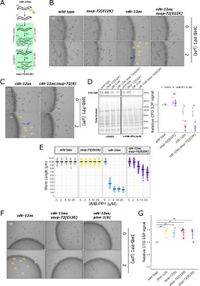Researchers have made significant strides in unraveling the complex mechanisms regulating developmental processes in the nematode Caenorhabditis elegans, focusing on the SSUP-72/PINN-1 module and its interactions with RNA polymerase II (Pol II). This study, published on March 17, 2025, identifies this module as pivotal suppressors of growth defects resulting from the inhibition of CDK-12, highlighting its role during the developmental phase post-embryogenesis.
The developmental transition from the first larval stage (L1) to subsequent growth phases is intricately controlled by gene expression patterns, which are mediated by hormonal signals and genetic regulation. At transition points, C. elegans often experiences developmental arrest due to nutrient availability and environmental factors. CDK-12 inhibition leads to the impaired expression of growth-related genes, causing L1 developmental arrest. This study aims to clarify how SSUP-72/PINN-1 can counteract these developmental hindrances.
Utilizing genetic screening techniques, researchers conducted mutagenesis on cdk-12 mutant strains to identify suppressor mutations capable of bypassing the arrest. They discovered a mutation within the ssup-72 gene, resulting in the variant denoted as E22K, which exhibited rescue effects on growth under CDK-12 suppression. This finding was substantiated through CRISPR-Cas9 gene editing, wherein the ssup-72[E22K] allele was shown to restore the requisite gene expression and developmental continuity.
Importantly, the SSUP-72 gene encodes for the CTD S5P phosphatase, which is known to play roles beyond just transcription termination. Researchers found SSUP-72 to be closely linked to the modulation of Pol II dynamics, particularly 3′ pausing on operonic genes, which are clusters of functionally-related genes transcribed together. This operonic arrangement is conserved as it allows for efficient transcription and regulation of growth-critical genes.
The study revealed fascinating insights about how the molecular architecture of operons impacts gene expression. For transcription to proceed without interruption, SSUP-72/PINN-1 interaction is key, leading to restored levels of mRNAs transcribed from operonic genes even under otherwise unfavorable conditions. Utilizing Global Run On sequencing (GRO-seq) allowed researchers to visualize Pol II occupancy across gene landscapes, confirming hypotheses about transcriptional elongation.
"Loss of SSUP-72/PINN-1 bypasses the requirement for CDK-12 in post-embryonic development," wrote the authors of the article, emphasizing the significance of their findings. Pol II dynamics were observed to change remarkably when CDK-12 was inhibited, characterized by increased transcriptional occupancy across active genes, particularly affecting operonic structures. The restoration of mRNA levels for genes typically downregulated following CDK-12 inhibition indicated the effective role of SSUP-72, underscoring its importance as both stabilizer and regulator within this molecular framework.
Further analysis conducted using RNA sequencing showed remarkable shifts within gene expression, particularly noting how 50% of the operonic genes affected by CDK-12 inhibition were upregulated when the suppressive E22K variant was present. These data highlight the broad regulatory capacity of the SSUP-72/PINN-1 module, which not only mitigates developmental arrest but also suggests greater intricacies behind operonic regulation.
Interestingly, the study also explored the mechanism by which SSUP-72 regulates Pol II dynamics. It becomes evident through data analysis, including western blots and transcriptomics, how dephosphorylation by SSUP-72 influences elongation rates and transcription processivity, thereby colloquially controlling how transcription terminates. Observing the effects of this phosphatase on gene expression elaborated on the molecular pathways governing developmental biology and laid the groundwork for future inquiries.
"Together, these data suggest SSUP-72 controls Pol II speed on TES, which kinetically impacts 3′ processing events," hinted at the multifaceted roles of SSUP-72, implying lessons not only about C. elegans but potentially extending to broader biological contexts, including human health and disease.
This study's findings steer future research directions toward exploring the SSUP-72/PINN-1 regulatory module as integral not only for C. elegans development but also as targets for therapeutic interventions against developmental disorders linked to transcriptional dysregulation. Understanding the nuances of trans-splicing and its dependencies on phosphatase activity will be key as researchers continue probing the complex interactions governing gene expression and development.




